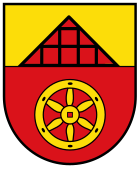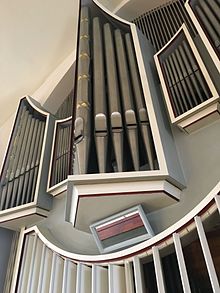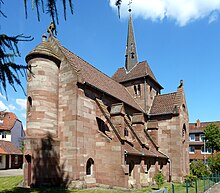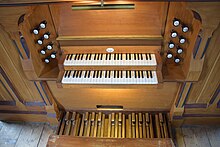Gieboldehausen
| coat of arms | Germany map | |
|---|---|---|

|
Coordinates: 51 ° 37 ' N , 10 ° 13' E |
|
| Basic data | ||
| State : | Lower Saxony | |
| County : | Goettingen | |
| Joint municipality : | Gieboldehausen | |
| Height : | 150 m above sea level NHN | |
| Area : | 19.86 km 2 | |
| Residents: | 3988 (Dec. 31, 2019) | |
| Population density : | 201 inhabitants per km 2 | |
| Postal code : | 37434 | |
| Area code : | 05528 | |
| License plate : | GÖ , DUD, HMÜ, OHA | |
| Community key : | 03 1 59 014 | |
| LOCODE : | DE 73R | |
| Address of the municipal administration: |
Hahlestr. 1 37434 Gieboldehausen |
|
| Website : | ||
| Mayoress : | Maria Bock ( CDU ) | |
| Location of the community of Gieboldehausen in the district of Göttingen | ||
Gieboldehausen is a patch and the seat of the Gieboldehausen joint community in the district of Göttingen in southern Lower Saxony ( Germany ).
geography
Gieboldehausen is located about 11 kilometers north of Duderstadt and 22 kilometers east of Göttingen on the northern edge of the Untereichsfeld . The district is located at the confluence of the Hahle and Rhume rivers on the edge of the Golden Mark . The ridge of the Rotenberg runs north and east ( Heimkenberg : 274 m, Kethanteichskopf : approx. 260 m), in the southeast the northern foothills of the Hellberge ( Lohberg : 228 m) begin . The Rhumeaue / Ellerniederung / Gillersheimer Bachtal nature reserve is located on the northern outskirts .
Neighboring towns are Bodensee , Bilshausen , Hattorf am Harz , Rollshausen , Wollershausen , Wollbrandshausen and Rüdershausen .
history
middle Ages
Gieboldehausen was first mentioned on May 25, 1003 by King Heinrich II under the name "Gebehildehuson". This makes the place one of the few settlements whose name refers to a female personal name - Gebehild. It is believed that between 500 and 800 AD, a cluster of villages emerged from the surrounding desert . Various mentions suggest that there was a castle in Gieboldehausen as early as the 10th century. This assumption arose from the fact that the Gandersheim Monastery issued two confirmations of ownership for the Church of St. Laurentius in Gieboldehausen in 1256 and 1324. This was preceded by a transfer from Count Biso, who had left his castle and other possessions in Gieboldehausen to the Gandersheim monastery. In 1291 the castle was mentioned again in connection with its destruction by the Hildesheim Bishop Siegfried II of Querfurt . In the same century, the castle also performed central administrative tasks. It was the administrative center for the surrounding villages and the seat of the officials , which are attested from the 14th century. The no longer preserved Eulenburg near the Rhume appeared as the seat of the Burgmannen . The “house on the wall”, which still exists today, was also used as a castle man's seat. From the 13th century onwards, Duke Heinrich I owned Gieboldehausen, who bequeathed the place to his three sons, Heinrich , Ernst and Wilhelm , who subsequently owned the town together. In 1334 Ernst pledged his third to his brother Heinrich, who in turn gave his half of the town, with the court of Bernshausen , to Baldwin the Archbishop of Trier on August 9 of the same year as a pledge. He was to keep the goods assigned to him until 1336, he paid 600 marks and made his promise to invest 100 marks in Gieboldehausen Castle. The redemption in 1336 did not take place, the place remained pledged until 1341 before Duke Heinrich II. Gieboldehausen to the Elector of Mainz, Heinrich III. sold. The half that had meanwhile been pledged to Count Otto von Lutterberg was redeemed for 200 marks. Thereupon Otto von Lutterberg, Hartmann von Sulingen and the rest of the Burgmannen, along with the residents of the village, paid homage to the new master. He assured them that they would keep their old rights and habits. A feud in the early 15th century brought Gieboldehausen in the possession of Count Heinrich of Hohnstein and his sons Henry, Ernst and Günther, and the Hessian Landgrave Hermann II. After the peace agreement they entered the place back to the Elector of Mainz John II. From , who pledged Gieboldehausen to his brother Adolf von Nassau, the senior bailiff of the Eichsfeld, but made the condition that he should build 2000 guilders on the castle within four years.
Since 1450 Gieboldehausen has been referred to in the springs as a Flecken and had market and brewing rights . The ascent to the Flecken may also be due to the fact that the towns of Bennigeshausen , Dodenhausen , Gerbershausen , Jakobshagen , Lemmershausen , Marsfeld and Werkshausen in the Gieboldehäsuener Feldflur were destroyed during this period. Their residents moved to Gieboldehausen after abandoning their villages.
Modern times
In the following years, the place experienced its hardest time during the wars of the 17th and 18th centuries. He was obliged to billet and make contributions, and was largely affected by looting. In addition, there were always fires that destroyed parts of Gieboldehausen. These occurred in 1694, 1712 and 1850, and in 1850, just a few days after the fire, a cholera epidemic struck the town , killing 324 people. Until the introduction of the district order in 1885, Gieboldehausen was the judicial and administrative seat of the office of the same name in the Untereichsfeld. With the loss of the official seat as part of the new district order of 1885, a supporting element of the place was lost, which has strongly shaped Gieboldehausen in its history. Only the district court remained in existence until 1932. Gieboldehausen became the center of the joint municipality of the same name in 1971.
Judiciary
The "Court of Gieboldehausen" was first mentioned in 1396. It probably developed from the Mainz Vogtgericht after Gieboldehausen's transition from Braunschweig to Mainz. Originally this jurisdiction was in contrast to the Gogericht , which was located in Bernshausen . The solution was finally the merger of the preferential jurisdiction in the Goger jurisdiction. In this way, the Gieboldehäusener bailiffs in Bernshausen held the district court in place of the approved judges from the middle of the 15th century, the judge of the Gieboldehausen office led from this point in time the title of judge. A shift in the social position of these judges took place from the end of the 15th century. No longer the local nobility occupied the positions, but rather bourgeois residents increasingly pushed into the office of judge. The focus of jurisdiction in the Gieboldehausen office remained Bernshausen, even if Gieboldehausen now had its own court. According to Reuter's camp book of 1684, it was mainly the residents of Gieboldehausen who appeared before the court in their own village. Here, the local court, as that in Bernhausen, except the judge from an actuary and twelve consisted aldermen . The important position of the Gieboldehäusener district judge becomes clear if one turns one's gaze to the point that he was the deputy of the Rusteberger Oberamtmann who presided over all the places of jurisdiction of the office. The district judge also gave the Duderstädter Stadtschultheissen to the western court in front of Duderstadt until the end of the Mainz electoral state. The separation of the administration and the court did not take place until 1852 as part of Windthorst's judicial reform. When the Kingdom of Hanover dissolved the Lindau District Court in the course of reducing the number of local courts in its territory , it was added to the one in Gieboldehausen in 1859. This in turn came to an end on October 1, 1932, when it was merged with the Duderstädert District Court.
politics
Municipal council
The municipal council from Gieboldehausen consists of 15 council members, including the part-time mayor.
| CDU | GfG | SPD | GREEN | FDP | total | |
| 2016 | 9 | 4th | - | 2 | - | 15 seats |
| 2011 | 6th | 4th | 3 | 1 | 0 | 14 seats |
| 2006 | 9 | - | 4th | - | 2 | 15 seats |
coat of arms
The coat of arms description reads: shield divided; above in gold a red pediment with black half-timbered beams; below in red the six-spoke golden Kurmainzer wheel .
Town twinning
Attractions
Catholic Church of St. Laurentius
The church of St. Laurentius, built from sandstone blocks, has a decisive influence on the appearance of Gieboldehausen due to its size and location on a hill. It was built in 1727-29 according to plans by the Benedictine Father Philipp Kersten, with considerable remains of the previous Gothic building being included. This previous building, a church in the Gothic style, was built in 1441, the buttresses, the west wall and a western vaulted yoke are among the preserved and included components. One example of the continued use of the old church are the buttresses, which were continued vertically through baroque pilaster strips to the edge of the roof. Inside the church there is a three-axis high altar from 1754 and a pulpit from 1733. The church of St. Laurentius, with its 42 m long and 14 m wide nave, is one of the stately sacred buildings in the lower area . A special feature is the vaulting of the groin inside. It testifies to the stylistic discrepancy between the architecture, which is manifested in the Gothic spatial conception of the places of worship, and the sculptural furnishings of the churches in Eichsfeld, which are baroque. In the Gieboldehausener church this circumstance is partially eliminated by the fact that the main altar and the side altars are linked by color, ornament and composition. However, the individual components are different in time, so they were not all created at the same time. The high altar was built almost 20 years later than the pulpit, which can be dated to the years 1732/1733 and for which the Duderstadt master Ernst Merten was responsible. In addition to a late Gothic Pietà, a wood-carved, baroque candlestick is one of the works of art in the church. This candlestick shows Saint Sebastian tied to a tree trunk and pierced with an arrow . On November 1, 2014, the churches in Lake Constance and Wollbrandshausen were added to the parish of Gieboldehausen , and in 2017 the church received a new baptismal and gospel bell.
organ
The organ was made in 1971 by the master organ builder Rudolf Krell from Duderstadt. It has 26 stops on 2 manuals and a pedal with mechanical action and electrical stop mechanics. The disposition is as follows:
|
|
|
||||||||||||||||||||||||||||||||||||||||||||||||||||||||||||
* Parts of this register can be found in the prospectus
- Coupling : II / I, I / P, II / P
- Playing aids : swell step for II, tongue switch, 2 free combinations
Bells
The bell founder Otto, who came from Eichsfeld, delivered three bronze bells to the St. Laurentius Church in Gieboldehausen in 1886, but these were melted down during the First World War. In 1919/20 the renowned Otto bell foundry from Hemelingen / Bremen delivered three new bronze bells. These are tuned to f - a flat - b. Their weights are: 1031 kg, 598 kg, 425 kg.
Ev.-luth. Gustav Adolf Church
In addition to the Catholic St. Laurentius Church, the Gustav Adolf Church, built in 1877 in neo-Gothic style, also exists in the village . It is used by the Evangelical Lutheran local congregation and is historically linked to historical and art-historical personalities. Empress Auguste , for example, appeared as a patron of the church alongside various Gustav Adolf associations. The builder of the church was the Hanoverian consistorial builder Conrad Wilhelm Hase , who was also responsible for the Marienburg near Hildesheim . The Gustav-Adolf-Kirche stands, connected with the name of the Hanoverian architect, as an example of the historical building direction of the Hanoverian school founded by Hase . The church is relatively small, the 6-bay nave including the choir is only 20 m long. Nevertheless, it has a three-aisled basilica structure with a transept and a distinctive strut system. The interior shows itself in a very simple picture, the ribs and a colored wooden cross with a romantic crucifix set color accents in the design of the room . On the side walls of the choir there are two paintings, one of which is a baroque oil painting depicting the birth of Christ and the other shows a picture of Christ. The latter was made in 1877 and was a gift from Empress Auguste for the inauguration of the church. The wooden pulpit comes from Hermann Schaper , a student of Conrad Wilhelm Hase. Among other things, he worked in the Göttingen town hall and performed the depiction of the four evangelists in the church on lowered zinc plates on the pulpit.
organ
In 1879, master organ builder Louis Krell from Duderstadt built an organ with 12 registers on 2 manuals and a pedal for the Gustav Adolf Church. In 1956/57 the sound of the organ was redesigned and its previously coherent sound concept was robbed. In 1979 a repair was carried out due to serious heating damage. Later the organ was completely restored and returned to the state of its time of origin. The "Mixtur" register added by Paul Ott (Göttingen) in 1956 was retained to enrich the sound palette. The work was carried out by Franz Rietzsch from Hiddestorf.
The current disposition of the organ with 13 registers is:
|
|
|
||||||||||||||||||||||||||||||||
- Coupling : II / I, I / P
- Tremulant
Bells
The bells of the church ask again a feature of the church. They were cast from French cannons in 1873 and make a gift of Kaiser Wilhelm I represent.
|
No. |
inscription |
Casting year |
Caster |
∅ (mm) |
Weight (kg) |
Norminal (16th note ) |
| 1 | "Cast from French cannons captured in the war of 1870/71" | 1873 | CF Ulrich, Apolda | 1160 | approx. 750 | f 1 |
| 2 | "Glory to God on high and peace on earth" | 1873 | CF Ulrich, Apolda | 925 | approx. 385 | a 1 |
lock
The manor house of the former castle mansion of the Lords of Minnigerode in Gieboldehausen is located south of the town center in a green area and is often referred to as the "castle". The representative building is the remainder of a larger estate. It is a three-storey building with two cantilevered half-timbered floors above a basement made of quarry stone with a steep, slate-covered roof with a central turret . The house was built at the beginning of the 16th century, but the massive basement and the vaulted cellar come from a previous building which, as a fortified stone house, was also surrounded by moats and which itself could have been built in place of an older moth . A former owner of the house can be cited as Hans von Brudenhusen, from whom Hans von Minnigerode the Younger bought the house, farm, fields and meadows in Gieboldehausen in 1502. Probably the "house on the wall" was also found among them. Hans von Minnigerode himself was named as Burgmann in Gieboldehausen from 1502 and acted as bailiff from 1521 to 1532. After 1520 he had the house built in its current form, with dendrochronological studies on the half-timbering dating back to 1528.
Burial mound on the Kleiner Lohberg
A group of 13 well-preserved burial mounds were discovered west of Gieboldehausen during archaeological soil explorations on the Kleiner Lohberg . Their size is 15 to 20 m in diameter with a height of 1 m. Analogies to similar burial mounds in the area suggest that the burial mounds date back to the Bronze Age . A few meters of the northeastern hills outside the forest, three small Middle Neolithic settlement areas were found.
traffic
Street
Gieboldehausen is connected to traffic via the B 27 (Göttingen- Braunlage ) and B 247 (Duderstadt- Northeim ). Furthermore, the district roads K 107 lead via Rüdershausen to Rhumspringe and the K 108 via Lütgenhausen and Wollershausen also to Rhumspringe.
Public transport
The Gieboldehausen train station was on the Leinefelde – Wulften railway line, which has now been converted into a cycle path . The next train stop is in Hattorf .
Gieboldehausen is connected to Rhumspringe and Duderstadt via the VSN bus line 162, to Duderstadt, Ebergötzen and Göttingen via line 170 and to Bilshausen and Ebergötzen via line 171. The buses are operated by the RBB .
Biking / hiking trails
The former railway line between Rollshausen and Wulften was completely converted into a cycle path. Furthermore extend fastened economic way to Wollbrandshausen. Due to the volume of traffic, the K 108 is also a good road for cyclists. A cycle path along the B 27 over the Rotenberg is also being planned.
education
In Gieboldehausen there is a cooperative comprehensive school, a primary school and two kindergartens.
Personalities
- Martin Beck (1109–1143), clergyman and minstrel at the Gandersheim monastery
- Franz Ignaz Wedekind (1710–1782), legal scholar
- Ludwig Hugo Ripping (1837–1898), psychiatrist
- Otto Meyer (1869–1947), teacher and poet, director of the German Aid School in Porto Alegre
- Werner Disse (1881–1962), mayor and district administrator
- Hugo Dittberner (* 1944), writer
- Willi F. Gerbode (* 1955), writer and literary cabaret artist
- Willi Döring (1924–1997), Mayor of Gieboldehausen, District Administrator, Member of the State Parliament (CDU)
- Klaus Keil (* 1954), theologian, musicologist, head of the central editorial office of the RISM
literature
- Alois Grobecker (Ed.): Flecken Gieboldehausen: Pictures from bygone days . Geiger, Horb am Neckar, 1988. ISBN 3-89264-229-X
- Sabine Wehking : The history of the office of Gieboldehausen . Mecke, Duderstadt, 1995. ISBN 3-923453-71-X
- Josef Koch, Heimatverein Goldene Mark (Hrsg.): Gieboldehausen: Historical images from a community . Mecke, Duderstadt, 1958.
- Sabine Wehking: The Chronicle of the Patch Gieboldehausen: 1003-2003 . Mecke, Duderstadt, 2003. ISBN 3-932752-97-X
- Ernst Andreas Friedrich : The former castle in Gieboldehausen in: If stones could talk . Volume IV, Landbuch-Verlag, Hannover 1998, ISBN 3-7842-0558-5
Web links
Individual evidence
- ↑ State Office for Statistics Lower Saxony, LSN-Online regional database, Table 12411: Update of the population, as of December 31, 2019 ( help ).
- ↑ Johann Wolf: Memories of the market town Gieboldehausen in the Harz department . JC Baier, Göttingen 1813, p. 13 f .
- ^ Carl Duval: The Eichsfeld or historical-romantic description of all cities, castles, palaces, monasteries, villages and other noteworthy points of the Eichsfeld . Eupel, Sondershausen 1845, p. 509 .
- ↑ https://wahlen.kdgoe.de/2016kw/Daten/159402_000125/index.html
- ↑ Gerhard Reinhold: Otto Glocken - family and company history of the Otto bell foundry dynasty, self-published, Essen 2019, 588 pages, ISBN 978-3-00-063109-2 , here in particular pp. 25, 110, 503, 520.
- ↑ Gerhard Reinhold: Church bells - Christian world cultural heritage, illustrated using the example of the bell founder Otto, Hemelingen / Bremen. Nijmegen 2019, 556 pages, Diss.Radboud Universiteit Nijmegen, nbn: nl: ui: 22-2066 / 204770, here in particular pp. 47, 48, 124, 125, 471, 484.
- ^ Klaus Grote : Gieboldehausen. Castle of the Lords of Minnigerode on the "Wall" . In: Guide to archaeological monuments in Germany - City and District of Göttingen . tape 17 , 1988, pp. 242 .
- ^ Klaus Grote: Gieboldehausen. Burial mound on the Kleiner Lohberg . In: Guide to archaeological monuments in Germany - City and District of Göttingen . tape 17 , 1988, pp. 240 .
- ^ OpenRailwayMap
- ↑ OpenCycleMap
- ^ Page of the city of Herzberg
- ^ Günther Schweikle: Minnesang , JB Metzler, Stuttgart 1995, ISBN 978-3476122445 , 2nd edition, page 144









